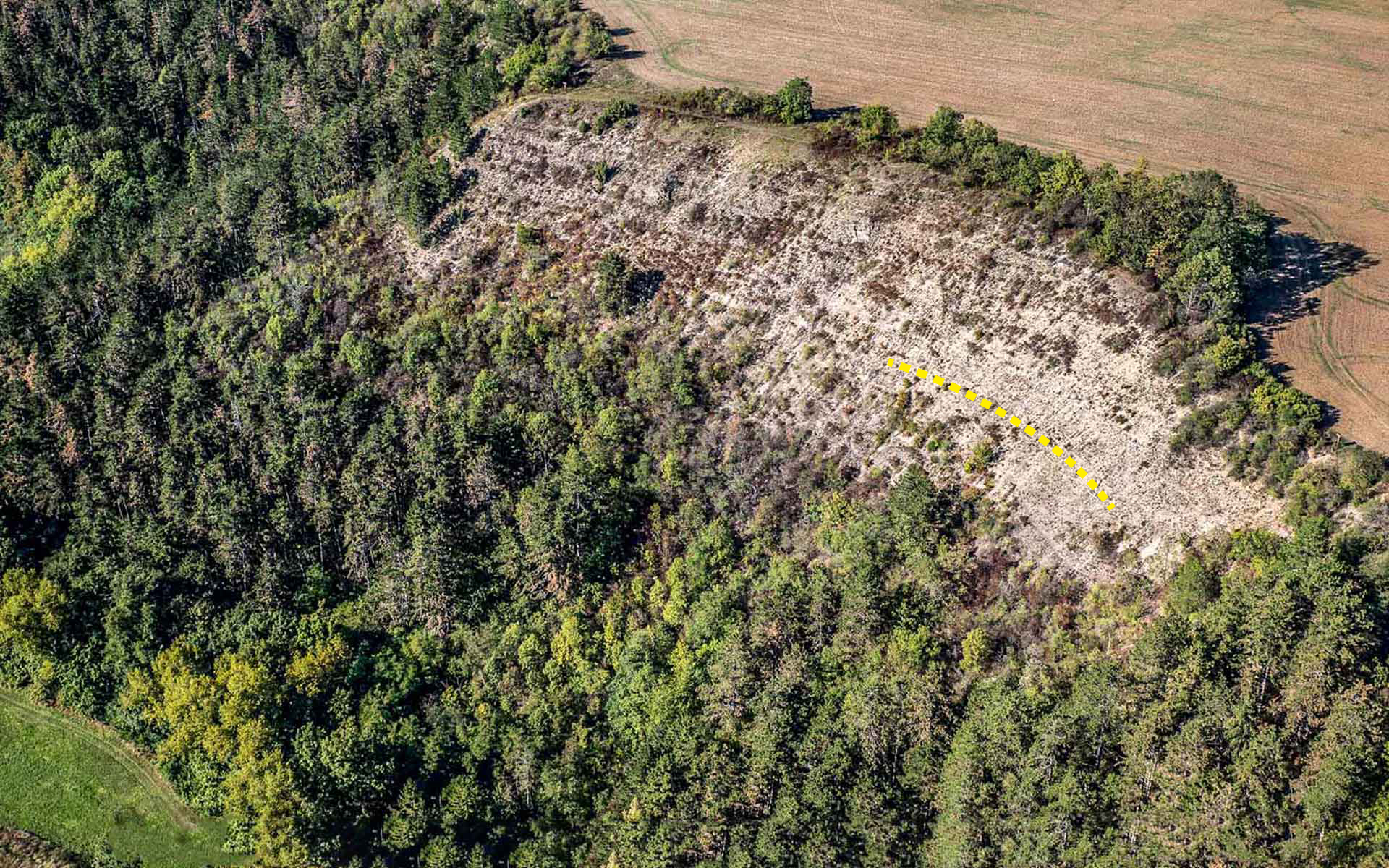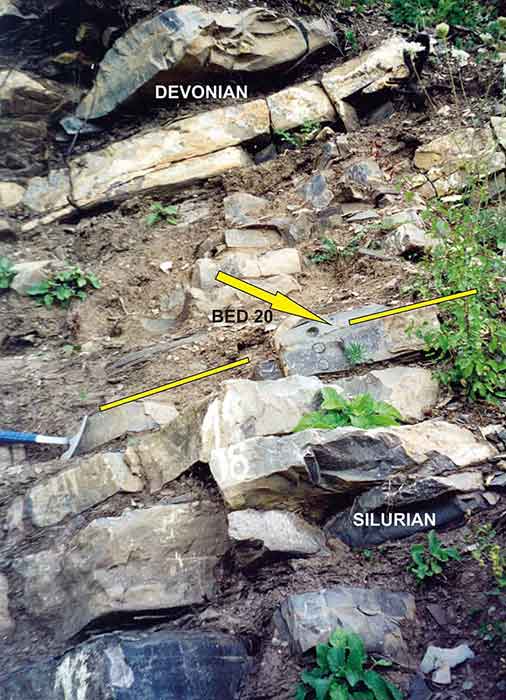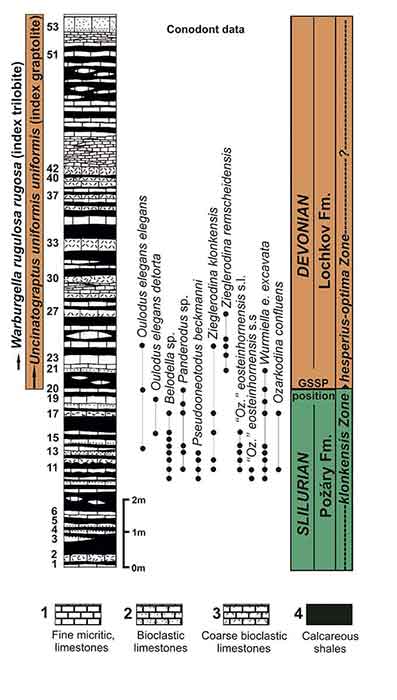
A view of the monument in front of the Klonk hill near Suchomasty B –The GSSP section. The yellow line marks the Silurian-Devonian boundary.
Geological Period
Silurian – Devonian
Main geological interest
History of geosciences
Stratigraphy and sedimentology
Location
Suchomasty village Central Bohemia Czech Republic.
49°54’03.0″N, 14°03’40.0″E
A view of the monument in front of the Klonk hill near Suchomasty B –The GSSP section. The yellow line marks the Silurian-Devonian boundary.
The first Global Boundary Stratotype Section and Point (GSSP).
During the second half of the 20th century the International Commission on Stratigraphy (ICS) and the International Union of Geological Sciences (IUGS) developed criteria and procedures for approval and formal ratification of GSSPs. This lead to the first GSSP at Klonk, what was ratiifed at the 24th International Geological Congress in Montreal 1972 . Since then, 77 more GSSPs have been ratified for the system, series, and stages of the ICS International Chronostratigraphic Chart – Geologic Time Scale. The GSSP for the Silurian-Devonian boundary at Klonk was the first achievement in the most successful multi-decadal, international endeavor of the International Commission on Stratigraphy.
- Geological description
The Klonk section is situated in the southwestern part of the Prague Synform, which is a part of Teplá-Barrandian Unit (Bohemian Massif, Czech Republic). In its present form, the central part of the Prague Synform is an asymmetrical elliptical structural depression, which represents an erosional relic of Lower Paleozoic volcanosedimentary successions (Knížek et al., 2010). The stratotype section itself is a large natural escarpment exposed on western slope of the Klonk hill. The GSSP boundary interval consists of a well bedded uppermost Silurian (Přídolí) and lowermost Devonian (Lochkovian) sequence formed by alternation of fine-grained, mostly dark grey limestone layers and dark calcareous shale layers. The first rock types correspond mostly to distal calciturbidite and current-related drifted sediment, and the latter have a significant proportion of pelagic material that was dissolved and condensed in early stages of lithification (Chlupáč et al., 1972; Chlupáč and Vacek, 2003, and Hladil, 1991). The S/D boundary level is in the upper part of bed No. 20 with no marked change in lithology where the index graptolite Uncinatograptus uniformis uniformis (Přibyl) first appears. Beside the base of the Devonian System, this level defines also the base of the Lower Devonian Series and the Lochkovian Stage.
- Scientific research and tradition
The problem of the Silurian-Devonian boundary had been controversial since the second half of the 19th century. It is known in literature as “The Hercynian Question”. Accordingly, the Klonk section since its first description (Chlupáč et al., 1972) attracted many specialists and more than 50 research articles appeared.
- Reference
Chlupáč, I., Jaeger, H. and Zikmundová, J. (1972) ‘The Silurian-Devonian Boundary in the Barrandian’, Bulletin of the Canadian petroleum Geology, 20(1), pp. 104–174. Available at: https://doi.org/10.35767/GSCPGBULL.20.1.104.
Chlupáč, I. and Vacek, F. (2003) ‘Thirty years of the first international stratotype: The Silurian-Devonian boundary at Klonk and its present status’, Episodes Journal of International Geoscience, 26(1), pp. 10–15. Available at: https://doi.org/10.18814/epiiugs/2003/v26i1/002.
Hladil, J. (1991) ‘Evaluation of the sedimentary record in the Silurian/Devonian boundary stratotype at Klonk (Barrandian area, Czechoslovakia)’, Newsletters on Stratigraphy, 25(2), pp. 115–125. Available at: https://doi.org/10.1127/nos/25/1991/115.
Slavík, L. (2017) ‘Summary of conodont data from the GSSP of the Silurian-Devonian boundary at Klonk near Suchomasty’, in International Conodont Symposium 4: Progress on Conodont investigation, Field Guide Book. Suttner, T.J., Valenzuela-Ríos, J.I., Liao, J.-C., Corradini, C. & Slavík, L. Berichte des Institutes für Erdwissenschaften, Karl-Franzens-Universität Graz, pp. 192–197.
Slavík, L. and Hladil, J. (2020) ‘Early Devonian (Lochkovian – early Emsian) bioevents and conodont response in the Prague Synform (Czech Republic)’, Palaeogeography, Palaeoclimatology, Palaeoecology, 549, p. 109148. Available at: https://doi.org/10.1016/j.palaeo.2019.04.004.
- Author(s)
Ladislav SLAVÍK
Institute of Geology of the Czech Academy of Sciences, v.v.i.


